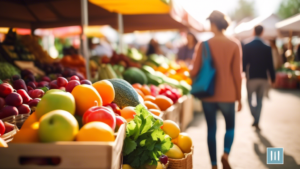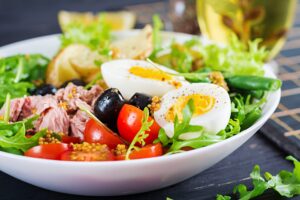Are you looking to eat healthier, but are worried about the cost of whole foods? Don’t fret! There are plenty of ways to incorporate nutritious whole foods into your diet without breaking the bank. By following some simple tips and tricks, you can enjoy a balanced and wholesome diet while staying within your budget.
One of the key strategies for eating whole foods on a budget is to shop seasonally and locally. Not only does this support local farmers and reduce your carbon footprint, but it can also save you money. By buying produce that is in season, you can take advantage of lower prices and fresher ingredients.
Additionally, meal planning and batch cooking can help you make the most of your groceries and minimize food waste. By preparing meals in advance and portioning them out, you can save time and money while ensuring that you always have healthy options on hand.
Key Takeaways
- Shop seasonally and locally for cost-effective and fresh produce
- Consider growing your own fruits and vegetables to save money
- Meal planning and batch cooking can help minimize food waste and save time
- Buying in bulk can save money on pantry staples like grains, beans, nuts, and seeds
Shopping Seasonally and Locally
Sure, because the best way to save money while eating whole foods is definitely by shopping seasonally and locally – because who needs those expensive out-of-season organic berries anyway? When you shop for fruits and vegetables that are in season, not only are you getting them at their peak freshness and flavor, but you’re also saving money since they’re more abundant and don’t have to travel far to reach your plate. Plus, buying locally grown produce supports your community’s farmers and reduces the carbon footprint of your meals.
By shopping seasonally and locally, you’re not only benefiting your wallet but also your health. Seasonal produce is often higher in nutrients since it’s picked at its peak ripeness, meaning you’re getting the most out of every bite. And when you support local farmers, you’re helping to preserve farmland and promote biodiversity in your area. So next time you’re at the farmer’s market or grocery store, opt for the in-season fruits and veggies – your taste buds and your budget will thank you.
Meal Planning and Batch Cooking
To save time and money, you should plan your meals ahead and cook in batches. By dedicating a little time each week to meal planning and batch cooking, you can enjoy healthy, homemade meals without breaking the bank. Here are three tips to help you get started:
- Create a Weekly Meal Plan: Sit down at the beginning of the week and plan out your meals. Consider what ingredients you already have and what you need to buy. This will prevent unnecessary trips to the store and impulse purchases.
- Cook in Bulk: Choose a day when you have some extra time to cook in bulk. Prepare large batches of your favorite dishes like soups, stews, or casseroles. You can portion them out and freeze them for later, making it easy to grab a homemade meal whenever you need it.
- Utilize Leftovers: Don’t let leftovers go to waste. Get creative and repurpose them into new dishes. For example, leftover roasted vegetables can be turned into a delicious frittata or added to a salad for a quick and easy meal. This not only saves you money but also reduces food waste.
By incorporating meal planning and batch cooking into your routine, you can eat whole foods on a budget while saving time and enjoying delicious, homemade meals.
Buying in Bulk
When buying in bulk, you can save money and stock up on essentials for less. By purchasing larger quantities of items like grains, beans, nuts, and seeds, you can enjoy significant savings over time. Not only does buying in bulk help you cut costs, but it also ensures that you always have pantry staples on hand for quick and easy meal preparation.
To help you make the most of buying in bulk, here’s a handy table that outlines common whole foods that you can purchase this way:
| Item | Benefits |
|---|---|
| Grains | Bulk grains like rice, quinoa, and oats are cost-effective and versatile for many recipes. |
| Beans | Buying dried fruits in bulk is a great way to enjoy the natural sweetness in your meals and snacks. |
| Nuts and Seeds | Stock up on nuts and seeds for snacking or adding crunch and nutrition to your dishes. |
| Dried Fruits | Buying dried fruits in bulk is a great way to enjoy natural sweetness in your meals and snacks. |
Utilizing Coupons and Discounts
When it comes to saving money on your grocery shopping, don’t overlook the power of coupons and discounts – they’re like little treasures waiting to be uncovered in the aisles of the store! Keep an eye out for coupons in newspapers, online, or even on the store’s app.
You’ll be surprised at how much you can save just by using a few coupons here and there. Additionally, many stores offer loyalty programs or discounts for signing up for their newsletters, so take advantage of these opportunities to save even more on your whole foods shopping.
Another great way to save with coupons is to stack them with store sales. Look for items that are already on sale and then use a coupon on top of that for double the savings. You can also check out discount websites or apps that offer deals on organic and whole food products. By combining coupons, discounts, and sales, you can stretch your budget while still enjoying nutritious whole foods for you and your family.
Growing Your Own Produce
One great way to save money and enjoy fresh produce is by growing your own fruits and vegetables. Not only is it a fun and rewarding experience, but it also allows you to have a constant supply of organic, nutrient-rich foods right at your fingertips. Imagine stepping out into your backyard or onto your balcony to pick some ripe tomatoes or crisp lettuce for your next meal. It not only saves you money but also ensures that you are consuming the freshest and most nutritious produce possible.
| Benefits of Growing Your Own Produce | Tips for Successful Gardening |
|---|---|
| 1. Cost-effective way to enjoy fresh produce | 1. Start small with easy-to-grow plants like herbs or cherry tomatoes |
| 2. Control over how your food is grown | 2. Research and follow planting and care instructions for each plant |
| 3. Fun and rewarding activity for the whole family | 3. Utilize compost and natural fertilizers to nourish your plants |
Frequently Asked Questions
Can eating whole foods on a budget still provide enough nutrients for a balanced diet?
Yes, like a gardener tending to their plants, carefully selecting whole foods on a budget can still provide all the essential nutrients for a balanced diet. It’s about nurturing your body with intention and care.
How can I incorporate more variety into my meals while sticking to a budget?
To add variety while sticking to a budget, try shopping seasonal produce, buying in bulk, and incorporating different grains and proteins. Get creative with spices and herbs to enhance flavors without breaking the bank.
Are there any specific kitchen tools or gadgets that can help make cooking whole foods easier and more efficient?
To make cooking whole foods easier and more efficient, consider investing in kitchen tools like a sharp chef’s knife, a high-speed blender, and a quality food processor. These gadgets will save you time and help you create delicious meals effortlessly.
Is it possible to find affordable organic options when shopping for whole foods?
Looking for affordable organic options? You’re in luck! Local farmers’ markets, co-ops, and online retailers offer budget-friendly choices. With a little research and creativity, you can enjoy nutritious whole foods without breaking the bank.
How can I prioritize spending on whole foods over processed or convenience foods when on a tight budget?
To prioritize spending on whole foods over processed or convenience foods on a tight budget, focus on essentials like fruits, vegetables, whole grains, and lean proteins. Plan meals, buy in bulk, cook at home, and embrace simple ingredients.














